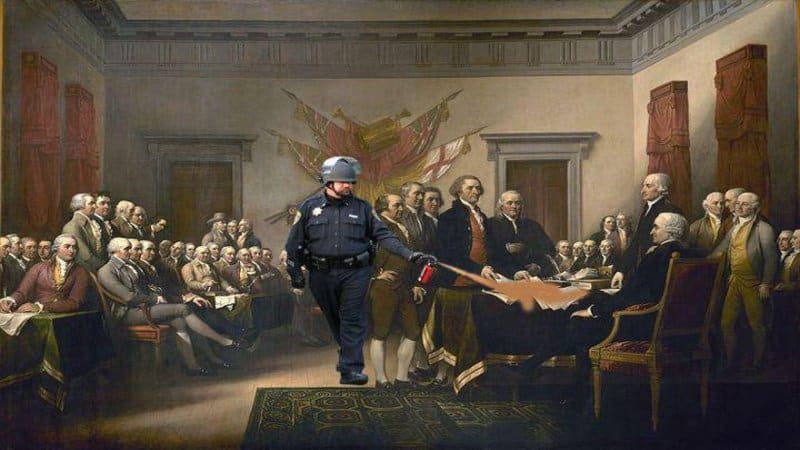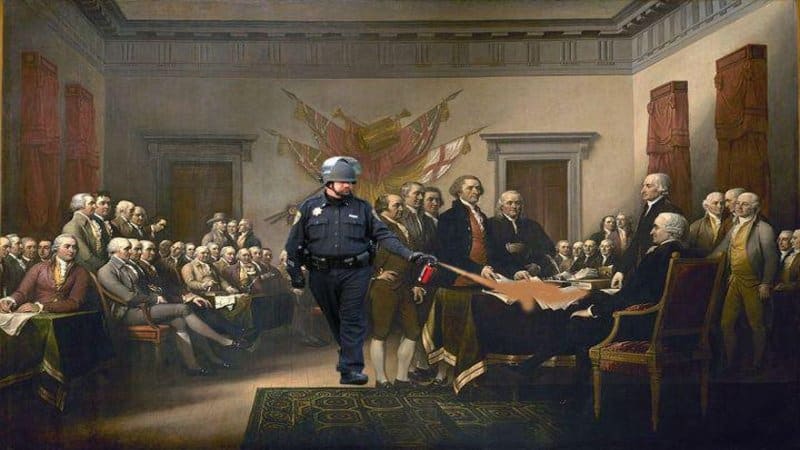
“The freedom of individuals verbally to oppose or challenge police action without thereby risking arrest is one of the principal characteristics by which we distinguish a free nation from a police state.” — Justice William J. Brennan, City of Houston v. Hill
What the architects of the police state want are submissive, compliant, cooperative, obedient, meek citizens who don’t talk back, don’t challenge government authority, don’t speak out against government misconduct, and don’t step out of line.
What the First Amendment protects—and a healthy constitutional republic requires—are citizens who routinely exercise their right to speak truth to power.
It’s not an easy undertaking.
Weaponized by police, prosecutors, courts and legislatures, “disorderly conduct” charges have become a convenient means by which to punish those individuals who refuse to be muzzled.
Cases like these have become all too common, typical of the bipolar nature of life in the American police state today: you may have distinct, protected rights on paper, but dare to exercise those rights and you put yourself at risk for fines, arrests, injuries and even death.
This is the unfortunate price of freedom.
Yet these are not new developments.
We have been circling this particular drain hole for some time now.
Almost 50 years ago, in fact, Lewis Colten was arrested outside Lexington, Kentucky, for questioning police and offering advice to his friend during a traffic stop.
Colten was one of 20 or so college students who had driven to the Blue Grass Airport to demonstrate against then-First Lady Pat Nixon. Upon leaving the airport, police stopped one of the cars in Colten’s motorcade because it bore an expired, out-of-state license plate. Colten and the other drivers also pulled over to the side of the road.
Fearing violence on the part of the police, Colten exited his vehicle and stood nearby while police issued his friend, Mendez, a ticket and arranged to tow his car. Police repeatedly asked Colten to leave. At one point, a state trooper declared, “This is none of your affair . . . get back in your car and please move on and clear the road.”
Insisting that he wanted to make a transportation arrangement for his friend Mendez and the occupants of the Mendez car, Colten failed to move away and was arrested for violating Kentucky’s disorderly conduct statute.
Colten subsequently challenged his arrest as a violation of his First Amendment right to free speech and took the case all the way to the US Supreme Court, which sided with the police.
Although the Court acknowledged that Colten was not trespassing or disobeying any traffic regulation himself, the majority affirmed that Colten “had no constitutional right to observe the issuance of a traffic ticket or to engage the issuing officer in conversation at that time.”
The Supreme Court’s bottom line: protecting police from inconvenience, annoyance or alarm is more important than protecting speech that, in the government’s estimation, has “no social value.”
While the ruling itself was unsurprising for a judiciary that tends to march in lockstep with the police, the dissent by Justice William O. Douglas is a powerful reminder that the government exists to serve the people and not the other way around.
Stressing that Colten’s speech was quiet, not boisterous, devoid of “fighting words,” and involved no overt acts, fisticuffs, or disorderly conduct in the normal meaning of the words, Douglas took issue with the idea that merely by speaking to a government representative, in this case the police—a right enshrined in the First Amendment, by the way—Colten was perceived as inconveniencing and annoying the police.
In a passionate defense of free speech, Douglas declared:
Since when have we Americans been expected to bow submissively to authority and speak with awe and reverence to those who represent us? The constitutional theory is that we the people are the sovereigns, the state and federal officials only our agents. We who have the final word can speak softly or angrily. We can seek to challenge and annoy, as we need not stay docile and quiet. The situation might have indicated that Colten’s techniques were ill-suited to the mission he was on, that diplomacy would have been more effective. But at the constitutional level speech need not be a sedative; it can be disruptive.
It’s a power-packed paragraph full of important truths that the powers-that-be would prefer we quickly forget: We the people are the sovereigns. We have the final word. We can speak softly or angrily. We can seek to challenge and annoy. We need not stay docile and quiet. Our speech can be disruptive. It can invite dispute. It can be provocative and challenging. We do not have to bow submissively to authority or speak with reverence to government officials.
Now in theory, “we the people” have a constitutional right to talk back to the government.
In fact, the US Supreme Court concluded as much in City of Houston v. Hill when it struck down a city ordinance prohibiting verbal abuse of police officers as unconstitutionally overbroad and a criminalization of protected speech.
In practice, however, talking back—especially when the police are involved—can get you killed.
The danger is real.
We live in an age in which “we the people” are at the mercy of militarized, weaponized, immunized cops who have almost absolute discretion to decide who is a threat, what constitutes resistance, and how harshly they can deal with the citizens they were appointed to “serve and protect.”
While violent crime in America remains at an all-time low, the death toll as a result of police-sponsored violence continues to rise. In fact, more than 1,000 people are killed every year by police in America, more than any other country in the world.
What we are dealing with is a nationwide epidemic of court-sanctioned police violence carried out against individuals posing little or no real threat.
I’m not talking about the number of individuals—especially young people—who are being shot and killed by police for having a look-alike gun in their possession, such as a BB gun. I’m not even talking about people who have been shot for brandishing weapons at police, such as scissors.
I’m talking about the growing numbers of unarmed people are who being shot and killed for just standing a certain way, or looking a certain way, or moving a certain way, or not moving fast enough, or asking a question, or not answering a question, or holding something—anything—that police could misinterpret to be a gun, or igniting some trigger-centric fear in a police officer’s mind that has nothing to do with an actual threat to their safety.
This is not what life should be like in a so-called “free” country.
Police encounters have deteriorated so far that anything short of compliance—including behavior the police perceive as disrespectful or “insufficiently deferential to their authority,” “threatening” or resistant—could get you arrested, jailed or killed.
The problem, of course, is that compliance is rarely enough to guarantee one’s safety.
Case in point: Miami-Dade police slammed a 14-year-old boy to the ground, putting him in a chokehold and handcuffing him after he allegedly gave them “dehumanizing stares” and walked away from them, which the officers found unacceptable.
According to Miami-Dade Police Detective Alvaro Zabaleta, “His body language was that he was stiffening up and pulling away… When you have somebody resistant to them and pulling away and somebody clenching their fists and flailing their arms, that’s a threat. Of course we have to neutralize the threat.”
This mindset that any challenge to police authority is a threat that needs to be “neutralized” is a dangerous one that is part of a greater nationwide trend that sets the police beyond the reach of the First and Fourth Amendments.
When police officers are allowed to operate under the assumption that their word is law and that there is no room for any form of disagreement or even question, that serves to destroy the First Amendment’s assurances of free speech, free assembly and the right to petition the government for a redress of grievances.
Then again, this is what happens when you take a police recruit, hype him (or her) up on the power of the gun in his holster and the superiority of his uniform, render him woefully ignorant of how to handle a situation without resorting to violence, drill him in military tactics but keep him in the dark about the Constitution, and never stress to him that he is to be a peacemaker and a peacekeeper, respectful of and subservient to the taxpayers, who are in fact his masters and employers.
The problem, as one reporter rightly concluded, is “not that life has gotten that much more dangerous, it’s that authorities have chosen to respond to even innocent situations as if they were in a warzone.”
What we’re dealing with today is a skewed shoot-to-kill mindset in which police, trained to view themselves as warriors or soldiers in a war, whether against drugs, or terror, or crime, must “get” the bad guys—i.e., anyone who is a potential target—before the bad guys get them.
Never mind that the fatality rate of on-duty police officers is reportedly far lower than many other professions, including construction, logging, fishing, truck driving, and even trash collection.
The result of this battlefield approach to domestic peacekeeping is a society in which police shoot first and ask questions later.
The message being drummed into our heads with every police shooting of an unarmed citizen is this: if you don’t want to get probed, poked, pinched, tasered, tackled, searched, seized, stripped, manhandled, arrested, shot, or killed, don’t say, do or even suggest anything that even hints of noncompliance.
This is the “thin blue line” over which you must not cross in interactions with police if you want to walk away with your life and freedoms intact.
If ever there were a time to scale back on the mindset adopted by cops that they are the law and should be revered, feared and obeyed, it’s now.
It doesn’t matter where you live—big city or small town—it’s the same scenario being played out over and over again in which government agents, hyped up on their own authority and the power of their uniform, ride roughshod over the rights of the citizenry.
Americans as young as 4 years old are being leg shackled, handcuffed, tasered and held at gun point for not being quiet, not being orderly and just being childlike—i.e., not being compliant enough.
Americans as old as 95 are being beaten, shot and killed for questioning an order, hesitating in the face of a directive, and mistaking a policeman crashing through their door for a criminal breaking into their home—i.e., not being submissive enough.
And Americans of every age and skin color are being taught the painful lesson that the only truly compliant, submissive and obedient citizen in a police state is a dead one.
As a result, Americans are being brainwashed into believing that anyone who wears a government uniform—soldier, police officer, prison guard—must be obeyed without question.
Of course, the Constitution takes a far different position, but does anyone in the government even read, let alone abide by, the Constitution anymore?
If we just cower before government agents and meekly obey, we may find ourselves following in the footsteps of those nations that eventually fell to tyranny.
The alternative involves standing up and speaking truth to power. Jesus Christ walked that road. So did Mahatma Gandhi, Martin Luther King Jr., and countless other freedom fighters whose actions changed the course of history.
As I make clear in my book Battlefield America: The War on the American People, the American dream was built on the idea that no one is above the law, that our rights are inalienable and cannot be taken away, and that our government and its appointed agents exist to serve us.
It may be that things are too far gone to save, but still we must try.
Reprinted with permission from Rutherford Institute.

